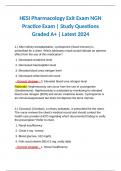HESI Pharmacology Exit Exam NGN
Practice Exam | Study Questions
Graded A+ | Latest 2024
1.) After kidney transplantation, cyclosporine (Sand immune) is
prescribed for a client. Which laboratory result would indicate an adverse
effect from the use of this medication?
1. Decreased creatinine level
2. Decreased haemoglobin level
3. Elevated blood urea nitrogen level
4. Decreased white blood cell count
- Correct Answer - 3. Elevated blood urea nitrogen level
Rationale: Nephrotoxicity can occur from the use of cyclosporine
(Sandimmune). Nephrotoxicity is evaluated by monitoring for elevated
blood urea nitrogen (BUN) and serum creatinine levels. Cyclosporine is
an immunosuppressant but does not depress the bone marrow.
2.) Cinoxacin (Cinobac), a urinary antiseptic, is prescribed for the client.
The nurse reviews the client's medical record and should contact the
health care provider (HCP) regarding which documented finding to verify
the prescription? Refer to chart.
1. Renal insufficiency
2. Chest x-ray: normal
3. Blood glucose, 102 mg/dL
4. Folic acid (vitamin B6) 0.5 mg, orally daily
- Correct Answer - 1. Renal insufficiency
,Rationale: Cinoxacin should be administered with caution in clients with
renal impairment. The dosage should be reduced, and failure to do so
could result in accumulation of cinoxacin to toxic levels. Therefore the
nurse would verify the prescription if the client had a documented history
of renal insufficiency. The laboratory and diagnostic test results are
normal findings. Folic acid (vitamin B6) may be prescribed for a client
with renal insufficiency to prevent anemia.
3.) A client with myasthenia gravis is suspected of having cholinergic
crisis. Which of the following indicate that this crisis exists?
1. Ataxia
2. Mouth sores
3. Hypotension
4. Hypertension - Correct Answer - 4. Hypertension
Rationale: Cholinergic crisis occurs as a result of an overdose of
medication. Indications of cholinergic crisis include gastrointestinal
disturbances, nausea, vomiting, diarrhea, abdominal cramps, increased
salivation and tearing, miosis, hypertension, sweating, and increased
bronchial secretions.
4.) A client with myasthenia gravis is receiving pyridostigmine
(Mestinon). The nurse monitors for signs and symptoms of cholinergic
crisis caused by overdose of the medication. The nurse checks the
medication supply to ensure that which medication is available for
administration if a cholinergic crisis occurs?
1. Vitamin K
2. Atropine sulfate
3. Protamine sulfate
4. Acetylcysteine (Mucomyst) - Correct Answer - 2. Atropine sulfate
Rationale:
,The antidote for cholinergic crisis is atropine sulfate. Vitamin K is the
antidote for warfarin (Coumadin). Protamine sulfate is the antidote for
heparin, and acetylcysteine (Mucomyst) is the antidote for
acetaminophen (Tylenol).
5.) A client with myasthenia gravis becomes increasingly weak. The
health care provider prepares to identify whether the client is reacting to
an overdose of the medication (cholinergic crisis) or increasing severity
of the disease (myasthenic crisis). An injection of edrophonium (Enlon) is
administered. Which of the following indicates that the client is in
cholinergic crisis?
1. No change in the condition
2. Complaints of muscle spasms
3. An improvement of the weakness
4. A temporary worsening of the condition
- Correct Answer - 4. A temporary worsening of the condition
Rationale:
An edrophonium (Enlon) injection, a cholinergic drug, makes the client in
cholinergic crisis temporarily worse. This is known as a negative test. An
improvement of weakness would occur if the client were experiencing
myasthenia gravis. Options 1 and 2 would not occur in either crisis.
6.) Carbidopa-levodopa (Sinemet) is prescribed for a client with
Parkinson's disease, and the nurse monitors the client for adverse
reactions to the medication. Which of the following indicates that the
client is experiencing an adverse reaction?
1. Pruritus
2. Tachycardia
3. Hypertension
4. Impaired voluntary movements
, - Correct Answer - 4. Impaired voluntary movements
Rationale:
Dyskinesia and impaired voluntary movement may occur with high
levodopa dosages. Nausea, anorexia, dizziness, orthostatic
hypotension, bradycardia, and akinesia (the temporary muscle
weakness that lasts 1 minute to 1 hour, also known as the "on-off
phenomenon") are frequent side effects of the medication.
7.) Phenytoin (Dilantin), 100 mg orally three times daily, has been
prescribed for a client for seizure control. The nurse reinforces
instructions regarding the medication to the client. Which statement by
the client indicates an understanding of the instructions?
1. "I will use a soft toothbrush to brush my teeth."
2. "It's all right to break the capsules to make it easier for me to swallow
them."
3. "If I forget to take my medication, I can wait until the next dose and
eliminate that dose."
4. "If my throat becomes sore, it's a normal effect of the medication and
it's nothing to be concerned about."
- Correct Answer - 1. "I will use a soft toothbrush to brush my teeth."
Rationale:
Phenytoin (Dilantin) is an anticonvulsant. Gingival hyperplasia, bleeding,
swelling, and tenderness of the gums can occur with the use of this
medication. The client needs to be taught good oral hygiene, gum
massage, and the need for regular dentist visits. The client should not
skip medication doses, because this could precipitate a seizure.
Capsules should not be chewed or broken and they must be swallowed.
The client needs to be instructed to report a sore throat, fever, glandular
swelling, or any skin reaction, because this indicates hematological
toxicity.




